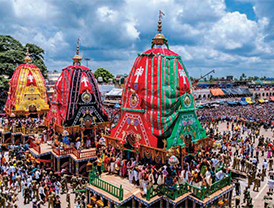Navakalevara: Statues are usually made of stone or metal but the four deities at Jagannath are made of wood. One of the grandest ceremonies associated with Lord Jagannath, the ‘Naba Kalabera’, takes place in a particular lunar month, usually in 12 or 18 years. Literally meaning the ‘New Body’ (Naba meaning new and Kalevar meaning body), the event involves installation of new images in the temple. The last idol ceremony was held in 2015.
Konark
The 13th Century Konark Temple, dedicated to the sun (Surya), the giver of energy, has exquisite stone carvings and is shaped like a massive chariot drawn by seven galloping horses with 12 pairs of stone-carved wheels. While the temple symbolises the passage of time, the seven horses represent the days of the week and the 12 pairs of wheels represent the 12 months of the year. ‘Konark’ is derived from the words Kona (corner) and Arka (Sun). As an architectural marvel, the three images of the Sun God are positioned in such a manner that they can catch the rays of the sun in the morning, noon and evening. Also it is believed that in the days of its glorious past, the Sun God idol would remain suspended in air with the help of a huge magnet in the dome and another which was fixed at the basement of the shrine. The same magnetic dome, European sailors believed, were causing shipwrecks along the coast and they used to call Konark the Black Pagoda. In contrast, the Jagannath temple in Puri was called the White Pagoda. Among the intricate carvings, interestingly, it is said that there is one of a giraffe signifying trade relations in the 13th Century with Africa. About Konark’s grandeur, the great poet Rabindranath Tagore had said, “Here the language of stone surpasses the language of man”. Konark is also home to the annual dance festival called Konark Dance Festival, which is held every December. To visit Konark, there are regular buses and jeeps from Bhubaneshwar, which is around 65 km and the best time to visit is from October to February.
Beaches
After the pilgrims have paid homage to Lord Jagannath, they head for the vast stretches of golden and white sand beaches of Puri. Here one could come across the sand sculptures (seen quite often in newspapers) created by Sudarshan Patnaik and which are inspired by temple sculptures, mythology or contemporary events. A unique thing about the Chandipur beach is that the sea water recedes for a few kilometres during low tide and the Balighai beach offers a clear view of the confluence of the river and the sea.
So, Odisha is a perfect getaway and has something for everyone whether they are religiousminded, architecture lovers, connoisseurs of dance forms, shutter-bugs or nature lovers. |SP
– By R Srinivasan


